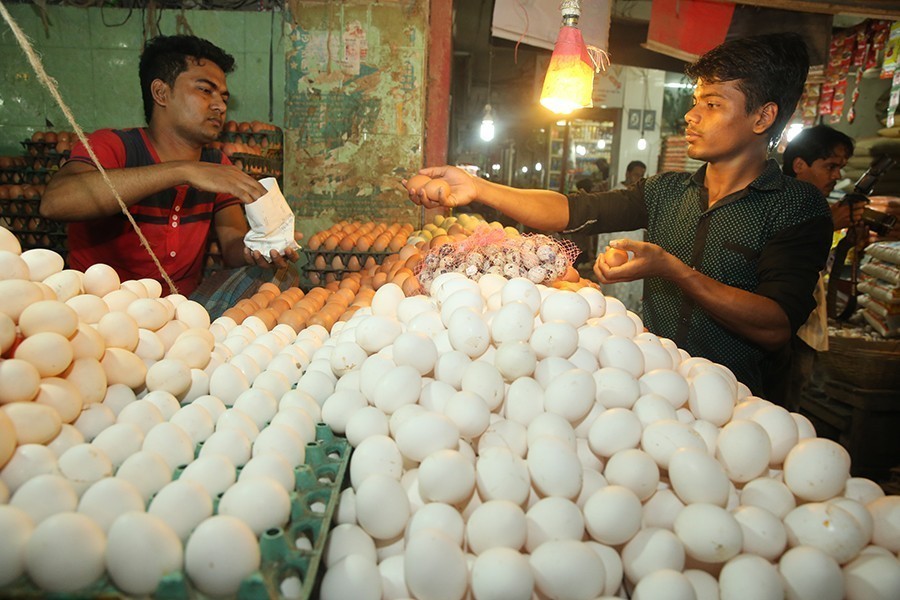How supply chain mismanagement leads to 'Eggsplosive' price hike

Published :
Updated :

Omar receives a notification on his phone that reads, "Eggs are now as affordable as water." Baffled, he recalls buying four eggs just a week ago for BDT 52. "How could egg prices drop so dramatically?"
However, his emotions are mixed with amusement and sadness when he sees a picture that compares a 500ml water bottle and a single egg, both costing BDT 15 – a shocking revelation.
This seemingly unbelievable scenario is indeed true. Egg prices have surged by 14.58% in the past month and a staggering 22.22% in the past year. The country's leading newspapers and social media are buzzing with concerns over this sudden and abnormal increase in egg prices in the capital, which unfolded in just 4 to 5 days. This skyrocketing cost has left a simple boiled egg out of reach for many, including rickshaw pullers and day labourers.
While creating a syndicate has drawn significant attention as a reason for this price spike, another crucial factor remains overlooked – the mismanagement within the supply chain. To grasp this issue, we need to delve into the intricacies of Bangladesh's supply chain
The poultry sector in Bangladesh predominantly relies on a traditional supply chain channel. The journey of poultry production begins with Day Old Chicks (DOCs) at the Grand Parent (GP) stock level. It progresses through breeder farming for Parent Stock (PS) up to commercial layers, closely intertwined with feed mills and hatcheries. These layer farms ultimately supply eggs to the market. DOCs are also imported.
The value chain includes various operations like commercial breeding of DOCs, input supplies (feed, vaccines, and medicines), layer production, collection, trading, and eventual consumption. Breeder farms incur the production cost of DOCs to make a profit.
Agents and dealers collect DOCs for layer farms, incurring transportation, electricity, rent, and other expenses while earning a commission. Wholesalers and retailers also bear common expenses like transport and labour costs, packaging expenses, and loss due to broken or damaged eggs, in addition to rent and electricity costs. Eventually, after taking a portion of the price as profit, these entities meet consumer demand.
However, when problems arise at any stage of this chain, involved parties tend to increase their margins to cover costs and, in some cases, manipulate prices. The following factors contribute to the erratic supply of eggs:
Escalating raw material costs: The price of local maize has surged by 21% since April, from Tk 26/kg to Tk 31.50/kg as of August 14. The devaluation of the taka against the dollar has been a contributing factor, leading to some major poultry companies shutting down.
Inadequate packaging: Poor packaging results in significant losses for wholesalers and retailers, who must absorb the cost of broken or damaged eggs.
Warehouse issues: Warehouses lack the necessary temperature control to maintain eggs properly.
Transportation woes: Poor road conditions and delivery vehicle problems, exacerbated by rainy weather and flooding in Chattogram, have led to considerable delivery delays.
Shortage of agents: Few company agents collect DOCs from breeding farms, especially from small-scale farmers.
Overreliance on dealers: Dealers play a crucial role in connecting large integrators and small-scale farmers, selling DOCs, medicine, and feed to small-scale producers and purchasing goods from them. However, they don't assume responsibility for assisting small-scale farmers, disrupting direct integration and increasing operating costs.
Impact of the Russia-Ukraine war: Imagine the absurdity of chickens laying eggs on the edge of the war zone between Russia and Ukraine! Yet, this is not far from reality, as most of the feed for the poultry comes from Ukraine. The conflict has disrupted the supply and increased the cost of grains for the hens.
Supply shortages: Both the supply of eggs and the number of suppliers in the country are limited, leading to the need for importing GP/PS DOCs to meet demand.
Several steps can be taken to address the problems in the poultry supply chain and bring down the price of eggs. These include:
- Implement baseline forecasting as part of demand planning to fulfil the needs of approximately 180 million people.
- Conduct Sales & Operations (S&OP) meetings to define the optimal supply points while understanding resource capacity.
- Prioritize supplier management for food grains and eggs, ensuring alternative sources for hen feed and fostering strong supplier relationships.
- Reduce dependence on dealers, making eggs more affordable while maintaining healthy profit margins for small-scale farmers.
- Consider seasonal variations in supply and transportation planning, particularly in flood-prone areas.
- Enhance packaging practices to reduce losses from broken or damaged eggs.
Lastly, implementing robust regulatory systems is essential to curb unethical trading practices and syndication. The growing demand of an ever-increasing population exerts significant pressure on producers and suppliers, making effective supply chain management critical to ensuring egg availability at reasonable prices.
As a final point, we can see the challenges that cause high prices by examining the complex factors that influence egg production and distribution in Bangladesh. Solving these problems effectively can lower the prices and make eggs more affordable to a larger group. Authorities must find a way to deal with this 'eggsquisite' dilemma.


 For all latest news, follow The Financial Express Google News channel.
For all latest news, follow The Financial Express Google News channel.